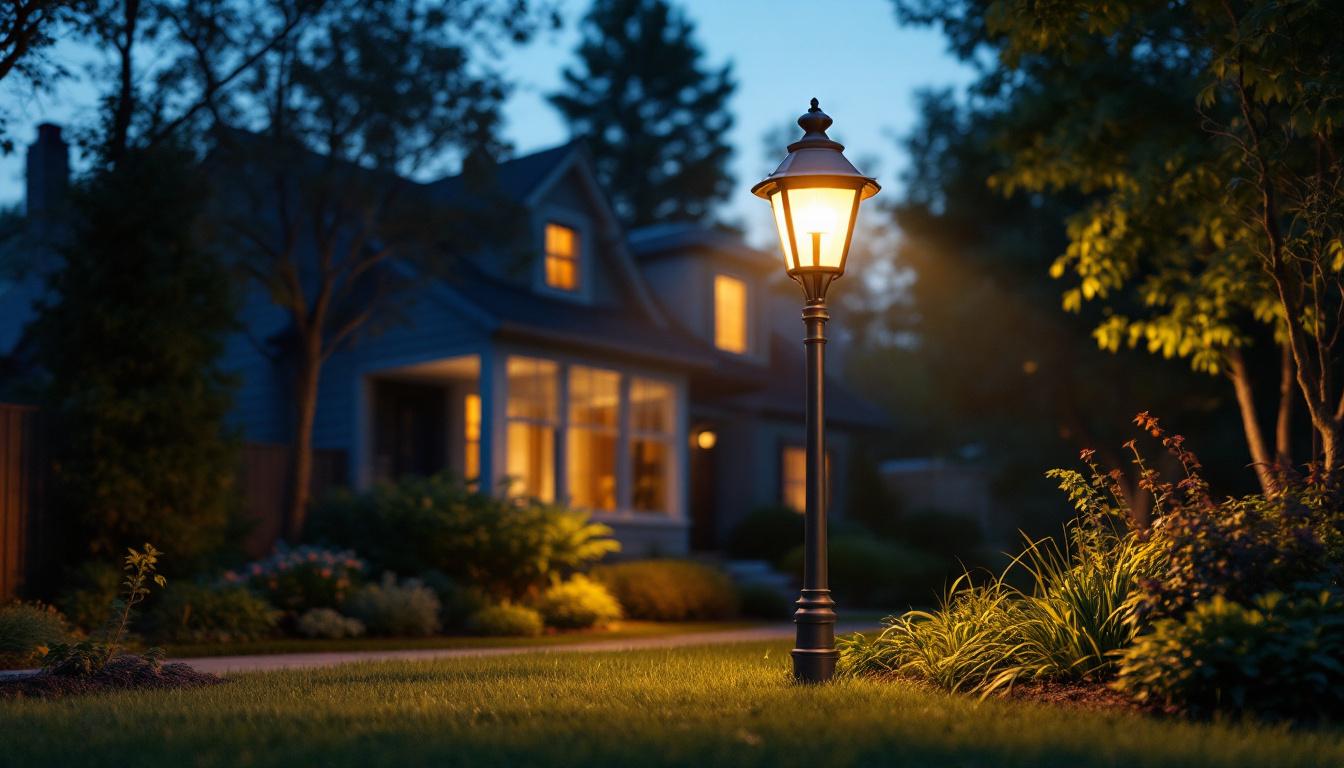
In the realm of outdoor lighting, yard pole lights have emerged as a vital component for enhancing visibility, security, and aesthetic appeal in residential and commercial properties. For lighting contractors, understanding the science behind these fixtures is essential for making informed decisions that meet client needs while adhering to industry standards. This article delves into the intricacies of yard pole lights, exploring their design, functionality, and the technology that powers them.
A yard pole light, often referred to as a pole-mounted light or street light, is a lighting fixture installed on tall poles to illuminate outdoor spaces. These lights are commonly used in driveways, parking lots, parks, and along pathways. Their height allows for a broader distribution of light, making them effective for enhancing safety and visibility in large areas.
Typically, yard pole lights are designed with durability in mind, often constructed from materials like aluminum or galvanized steel to withstand various weather conditions. They can be fitted with different types of bulbs, including LED, HID, or fluorescent, each offering distinct advantages in terms of energy efficiency, brightness, and lifespan.
The versatility of yard pole lights makes them suitable for a wide range of applications. In residential settings, they can illuminate driveways and gardens, providing both safety and aesthetic enhancements. In commercial environments, they are crucial for lighting parking lots and walkways, ensuring that customers and employees feel secure during nighttime hours.
Moreover, yard pole lights can be employed in public spaces, such as parks and recreational areas, contributing to community safety and enjoyment. Their strategic placement can deter criminal activity and encourage outdoor activities after dark, making them an essential feature in urban planning.
In addition to their practical uses, yard pole lights can also serve as a canvas for artistic expression. Many municipalities are now incorporating decorative designs and smart technology into these fixtures, allowing for customizable lighting options that can change color or intensity based on events or seasons. This not only enhances the visual appeal of public spaces but also engages the community, fostering a sense of pride and ownership over local environments.
Furthermore, advancements in solar technology have led to the development of solar-powered yard pole lights, which offer an eco-friendly alternative to traditional lighting solutions. These lights harness sunlight during the day and automatically illuminate at night, reducing energy costs and reliance on the electrical grid. This innovation is particularly beneficial in remote areas where conventional power sources may be limited, making outdoor spaces more accessible and safe for all users.
Understanding how light is distributed from yard pole lights is fundamental for lighting contractors. The effectiveness of a lighting installation depends not only on the type of light source used but also on the design of the fixture and the optics involved.
Different light sources emit light in various ways, impacting how effectively they illuminate an area. LED lights, for example, are known for their directional lighting capabilities, allowing for focused beams that reduce light pollution and improve energy efficiency. In contrast, traditional incandescent and fluorescent bulbs emit light in all directions, which can lead to wasted energy and uneven lighting.
When selecting a light source for yard pole lights, contractors must consider factors such as lumen output, color temperature, and energy consumption. LEDs are often favored for their longevity and low energy usage, making them a cost-effective choice in the long run. Furthermore, the color temperature of the light can influence the ambiance of the space; warmer tones create a cozy atmosphere, while cooler tones can enhance visibility and alertness, making them ideal for security applications.
The optics of a yard pole light play a crucial role in determining how light is distributed across a given area. Lens design can significantly affect the beam angle and intensity of the light. For instance, a narrow beam angle may be suitable for illuminating specific areas, such as a parking lot entrance, while a wider beam angle is better for general area lighting.
Contractors should also consider the materials used in lens construction. Polycarbonate and glass lenses offer different levels of durability and light transmission, impacting the overall performance of the lighting fixture. Understanding these factors can help contractors make informed decisions that enhance the efficacy of their installations. Additionally, the choice of lens can also affect maintenance; for example, polycarbonate lenses are often more resistant to impact and weathering, which can reduce the frequency of replacements and repairs, ultimately leading to lower long-term costs.
Moreover, the integration of advanced technologies such as smart sensors and adaptive lighting systems is becoming increasingly popular in modern lighting design. These innovations allow for real-time adjustments based on environmental conditions, such as dimming the lights during low-traffic periods or brightening them when motion is detected. Such features not only enhance safety and security but also contribute to energy savings, aligning with sustainability goals that many contractors and clients prioritize today.
In today’s environmentally conscious world, energy efficiency and sustainability are paramount considerations for lighting contractors. Yard pole lights, particularly those utilizing LED technology, offer significant advantages in this regard.
LED lights consume significantly less energy compared to traditional lighting options, which translates to lower electricity bills for clients. Additionally, they have a longer lifespan, often lasting up to 25 times longer than incandescent bulbs. This longevity reduces the frequency of replacements, minimizing waste and the environmental impact associated with manufacturing and disposing of lighting fixtures.
Moreover, many LED lights are designed to be dimmable, allowing for further energy savings by adjusting brightness levels based on the time of day or the presence of activity in the area. This adaptability enhances the overall sustainability of lighting installations.
Light pollution is a growing concern in urban areas, affecting both wildlife and human health. Yard pole lights designed with proper optics and shielding can help mitigate this issue by directing light where it is needed and minimizing glare. By selecting fixtures that comply with dark sky regulations, contractors can contribute to a more sustainable and environmentally friendly lighting solution.
Proper installation of yard pole lights is critical to their performance and longevity. Several factors must be taken into account to ensure that the lights function optimally and meet the needs of the space they illuminate.
The height of pole-mounted lights significantly influences their effectiveness. Generally, taller poles provide broader coverage, while shorter poles may require closer spacing to achieve similar illumination levels. Contractors must assess the specific requirements of the area, including the intended use and the desired brightness, to determine the optimal height and spacing for installation.
Additionally, the placement of yard pole lights should consider potential obstructions, such as trees or buildings, that could block light distribution. A well-planned layout will ensure that the light reaches all necessary areas without creating dark spots.
Electrical wiring for yard pole lights must be installed according to local codes and regulations. This includes ensuring that the wiring is rated for outdoor use and protected from moisture and other environmental factors. Proper grounding is also essential to prevent electrical hazards and ensure the safety of the installation.
Contractors should also consider the use of smart lighting controls, such as timers or motion sensors, which can enhance the functionality of yard pole lights. These controls allow for automated operation, further improving energy efficiency and convenience for clients.
Regular maintenance is essential to ensure that yard pole lights continue to operate effectively over time. Lighting contractors should educate clients on the importance of upkeep and provide guidance on best practices.
Conducting routine inspections of yard pole lights can help identify potential issues before they become significant problems. This includes checking for damaged fixtures, burned-out bulbs, and signs of corrosion or wear. Regular maintenance can extend the lifespan of the lighting system and ensure consistent performance.
Contractors may recommend a maintenance schedule that includes cleaning lenses to remove dirt and debris, which can obstruct light output. Keeping fixtures clean will enhance their efficiency and maintain the desired aesthetic appeal of the outdoor space.
As lighting technology continues to evolve, contractors should stay informed about new advancements that can improve the performance and efficiency of yard pole lights. Upgrading to newer LED models or incorporating smart technology can provide clients with enhanced features and greater energy savings.
By staying abreast of industry trends and innovations, contractors can offer valuable recommendations to clients, ensuring that their outdoor lighting remains effective and relevant in a rapidly changing market.
Yard pole lights play a crucial role in enhancing outdoor spaces, providing safety, visibility, and aesthetic appeal. For lighting contractors, understanding the science behind these fixtures is essential for delivering high-quality installations that meet client needs. From selecting the right light sources and optics to ensuring proper installation and maintenance, a comprehensive understanding of yard pole lights will enable contractors to excel in their field.
As the demand for energy-efficient and sustainable lighting solutions continues to grow, lighting contractors have a unique opportunity to lead the charge in adopting innovative technologies and practices. By prioritizing education and staying informed about industry advancements, contractors can not only enhance their own expertise but also contribute to a brighter, safer, and more sustainable future for outdoor lighting.
Ready to elevate your lighting installations with the most efficient, sustainable, and cost-effective solutions? Look no further than LumenWholesale. Our extensive range of spec-grade lighting products is designed to meet the highest industry standards, ensuring you deliver excellence in every yard pole light project. Say goodbye to inflated markups and hello to unbeatable wholesale prices, free shipping, and the convenience of bulk buying. Take the next step in outdoor lighting by choosing LumenWholesale, where quality meets affordability. Discover our selection and secure the best value for your lighting needs today at Wholesale Lighting at the Best Value.

Discover the ultimate hospital grade receptacles lighting contractors need.

Discover how lighting contractors can enhance their profitability with strategic insights and practical tips in our comprehensive guide on single receptacles.

Discover how strategic lighting choices in garages can lead to significant cost savings for lighting contractors.

Explore the essential insights lighting contractors need to meet client expectations in “Lotus Light.” Discover key trends, client preferences, and expert tips to illuminate your projects with precision and creativity..